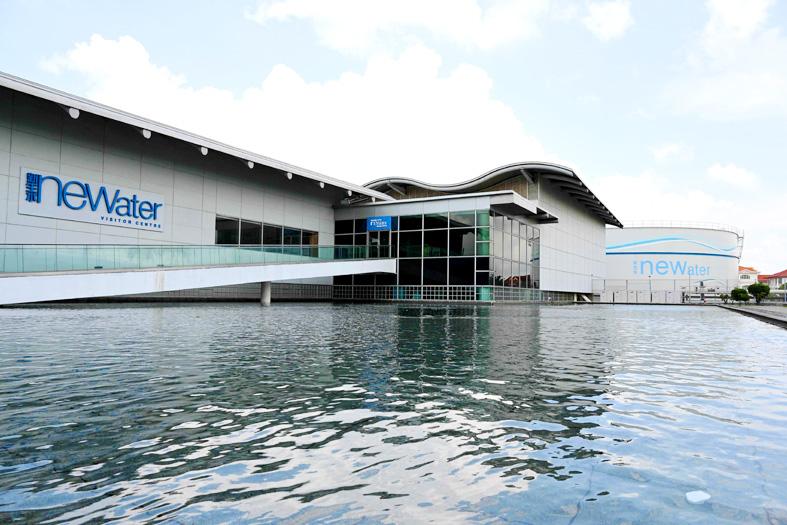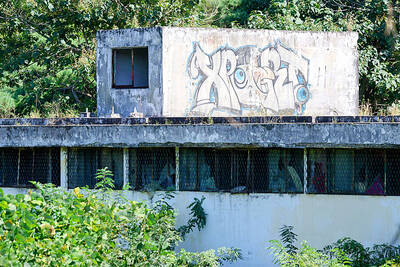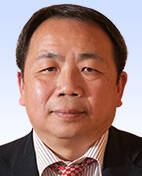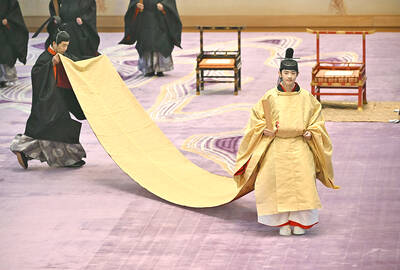Giant pumps whir deep underground at a plant in Singapore that helps transform sewage into water so clean it is fit for human consumption while reducing ocean pollution.
The tiny island nation has little in the way of natural water sources and has long had to rely principally on supplies from Malaysia.
To boost self-sufficiency, the government has developed an advanced system for treating sewage involving a network of tunnels and high-tech plants.

Photo: AFP
Recycled wastewater can now meet 40 percent of Singapore’s water demand — a figure that is expected to rise to 55 percent by 2060, the National Water Agency said.
While most is used for industrial purposes, some of it is added to drinking water supplies in reservoirs in the city-state of 5.7 million people.
Moreover, the system helps reduce maritime pollution, as only a small amount of the treated water is discharged into the sea.
This is a contrast to most other countries — 80 percent of the world’s wastewater flows back into the ecosystem without being treated or reused, UN estimates show.
“Singapore lacks natural resources and it is limited in space, which is why we are always looking for ways to explore water sources and stretch our water supply,” said Low Pei Chin, chief engineer of the Public Utilities Board’s water reclamation department.
One key strategy is to “collect every drop” and “reuse endlessly,” she added.
This is in addition to the city-state’s other main approaches to securing water supplies — importing it, using reservoirs and desalinating seawater.
At the heart of the recycling system is the high-tech Changi Water Reclamation Plant on the city’s eastern coast.
Parts of the facility in land-scarce Singapore are underground — some as deep as 25 stories — and it is fed by wastewater that flows through a massive, 48km tunnel linked to sewers.
The site houses a maze of steel pipes, tubes, tanks, filtration systems and other machinery, and can treat up to 900 million liters of wastewater a day — enough to fill an Olympic-sized swimming pool every 24 hours for a year.
In one building, a network of ventilators have been installed to keep the air smelling fresh, although a putrid whiff still hangs in the air.
Sewage that arrives at the plant undergoes an initial filtering process before powerful pumps send it flowing to facilities above ground for further treatment.
There, the treated water is further cleansed, with impurities like bacteria and viruses removed through advanced filtration processes and disinfected with ultraviolet rays.
The end product, dubbed “NEWater,” is mainly used in microchip manufacturing plants — which are ubiquitous in the city-state and require high-quality water — and for cooling systems in buildings.
However, it also helps boost drinking water supplies. During the dry season, it is sent to top up several reservoirs and, following further treatment, flows to people’s taps.
Singapore is expanding its recycling system. It plans to add an extra underground tunnel and a major water reclamation plant to serve the western half of the island, which should be completed by 2025.
Singapore will have spent S$10 billion (US$7.4 billion) on upgrading its water treatment infrastructure by the time the expansion is finished. One impetus to seek greater self-sufficiency are the city-state’s historically fractious relations with its key water source, Malaysia.
The neighbors have had stormy ties since Malaysia ejected Singapore from a short-lived union in 1965, and they have in the past had rows over water supplies.
Stefan Wuertz, a professor of environmental engineering at Singapore’s Nanyang Technological University, stressed the importance for other countries to treat wastewater more effectively, warning of serious long-term impacts otherwise.
“There is a limited amount of water on the planet,” he said.
“If we were to keep polluting the freshwater, at some stage we would reach the point where ... treatment becomes extremely expensive,” he said.

LANDMARK CASE: ‘Every night we were dragged to US soldiers and sexually abused. Every week we were forced to undergo venereal disease tests,’ a victim said More than 100 South Korean women who were forced to work as prostitutes for US soldiers stationed in the country have filed a landmark lawsuit accusing Washington of abuse, their lawyers said yesterday. Historians and activists say tens of thousands of South Korean women worked for state-sanctioned brothels from the 1950s to 1980s, serving US troops stationed in country to protect the South from North Korea. In 2022, South Korea’s top court ruled that the government had illegally “established, managed and operated” such brothels for the US military, ordering it to pay about 120 plaintiffs compensation. Last week, 117 victims

China on Monday announced its first ever sanctions against an individual Japanese lawmaker, targeting China-born Hei Seki for “spreading fallacies” on issues such as Taiwan, Hong Kong and disputed islands, prompting a protest from Tokyo. Beijing has an ongoing spat with Tokyo over islands in the East China Sea claimed by both countries, and considers foreign criticism on sensitive political topics to be acts of interference. Seki, a naturalised Japanese citizen, “spread false information, colluded with Japanese anti-China forces, and wantonly attacked and smeared China”, foreign ministry spokesman Lin Jian told reporters on Monday. “For his own selfish interests, (Seki)

Argentine President Javier Milei on Sunday vowed to “accelerate” his libertarian reforms after a crushing defeat in Buenos Aires provincial elections. The 54-year-old economist has slashed public spending, dismissed tens of thousands of public employees and led a major deregulation drive since taking office in December 2023. He acknowledged his party’s “clear defeat” by the center-left Peronist movement in the elections to the legislature of Buenos Aires province, the country’s economic powerhouse. A deflated-sounding Milei admitted to unspecified “mistakes” which he vowed to “correct,” but said he would not be swayed “one millimeter” from his reform agenda. “We will deepen and accelerate it,” he

Japan yesterday heralded the coming-of-age of Japanese Prince Hisahito with an elaborate ceremony at the Imperial Palace, where a succession crisis is brewing. The nephew of Japanese Emperor Naruhito, Hisahito received a black silk-and-lacquer crown at the ceremony, which marks the beginning of his royal adult life. “Thank you very much for bestowing the crown today at the coming-of-age ceremony,” Hisahito said. “I will fulfill my duties, being aware of my responsibilities as an adult member of the imperial family.” Although the emperor has a daughter — Princess Aiko — the 23-year-old has been sidelined by the royal family’s male-only